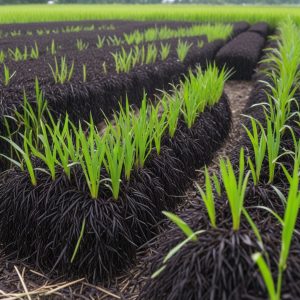Our Hero Products
Kissu Lip Mask – Capuacu butter, Jojoba oil & Rice Bran
Can we grow Black rice in United States?

Is it feasible to grow black rice in the United States? With its global popularity on the rise, this question emerges but did you try to find out? Nestled in the verdant fields of Southeast Asia, black rice has long fascinated food lovers and health enthusiasts. Known for its distinctive colour and rich, nutty taste, this ancient grain has been a cornerstone of Asian diets for centuries. Now let’s dive deep into this and find out whether black rice can be grown in the United States.

The Origins of Black Rice
Growing black rice at home means looking back at its past. Do you have a thought on where it initially originated? It originated in China where it has been cultivated for over 4000 years! It contains a high amount of anthocyanins which makes it unique in terms of color. They called it “forbidden rice” or “emperor’s rice” since it was served for the emperor of China and was used as a tribute food. Since then it remained popular in certain regions of China and was awarded recently for its high level of antioxidants. Relative to other rice varieties, forbidden rice is high in protein and iron; according to Chinese medicine, it is considered a blood tonic. Its high antioxidants, vitamins and mineral content have branded it a healthy food which raised interest in its cultivation beyond borders.
To know more about black rice, check out our blog!
Can the US Support Black Rice Cultivation?
One of the major concerns for growing black rice is the CLIMATE. Places where it grows well usually have warm and humid weather which is necessary for cultivating the rice. In the United States, states such as California, Louisiana and Texas have shown similar climatic conditions best suitable for the rice to grow. These states have the right warmth and adequate moisture for the rice fields to progress well.

challenges faced by the agriculturists
- Climate Suitability
- Certain US states have climates that align with black rice preferences.
- Challenges
- Rice cultivation requires specific agricultural practices, such as:
- Flooded fields
- Precise water management
- Black rice varieties may have different growth requirements than traditional US rice types.
- Rice cultivation requires specific agricultural practices, such as:
- Opportunities
- Advancements in agricultural technology
- Knowledge exchange with Asian rice-growing experts
Research and development
Determining if black rice can be grown in the United States depends on strong research and development. Agricultural colleges, government bodies, and farming groups work together to adapt black rice cultivation techniques. They study soil conditions to ensure black rice gets the nutrients it needs. They also fine-tune water management to mimic the flooded fields crucial for rice growth, ensuring black rice gets the right moisture levels.
Additionally, they tailor pest control measures for black rice, as different pests can affect this crop. They focus on optimizing harvesting methods to preserve the delicate grains and unique flavour of black rice. Researchers improve techniques like selective harvesting and careful post-harvest processing to meet the high-quality standards expected of black rice.
Market Demand for Black rice in the United States
The equation also considers market demand and consumer trends. Farmers and producers caught interest in black rice because it is unique and nutritious. With more people wanting diverse and healthy diets, black rice offers a new way to grow different crops in America and meet new consumer needs.
Universities, government agencies, farmers, and industry leaders promote innovation and share knowledge about growing black rice through partnerships. They share research findings, best practices, and success stories through workshops, conferences, and programs to help farmers and promote sustainable farming. Ongoing research, the use of sustainable methods, and market strategies make growing and enjoying locally grown black rice more possible. This improves food security, protects the environment, and adds to the culinary variety.
Conclusion
In sum, while introducing black rice cultivation to the US faces obstacles, the prospects are encouraging. The intersection of suitable climates, innovative research, and strong market interest lays a fertile ground for exploration. As farming methods progress and collaborative efforts grow, the vision of black rice fields under the American sky becomes increasingly feasible. This venture into cultivation, driven by discovery, innovation, and sustainability, stands to enrich our diets and the environment alike.



















 Gentle Face Cleanser - Rice Water & Birch Juice
Gentle Face Cleanser - Rice Water & Birch Juice
 Black Rice Toner - Hyaluronic Acid
Black Rice Toner - Hyaluronic Acid
 Face Glow Serum - Alpha Arbutin & Ferulic Acid
Face Glow Serum - Alpha Arbutin & Ferulic Acid
 Rice Ceramide Gel Cream
Rice Ceramide Gel Cream
 Kissu Lip Mask - Cupuacu & Rice Bran
Kissu Lip Mask - Cupuacu & Rice Bran
 Hair Growth Serum - Redensyl, Anagain & Rosemary
Hair Growth Serum - Redensyl, Anagain & Rosemary














